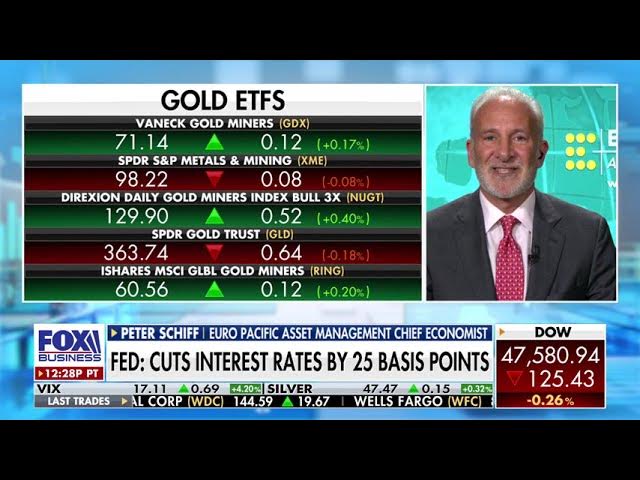
Fed decides to cut interest rates by 25 basis points
Peter Schiff
12,378 views • 2 days ago
Video Summary
The Federal Reserve's recent decision to cut rates and halt quantitative tightening (QT) has drawn sharp criticism from Peter Schiff, who argues it's a premature move that will exacerbate inflation. He points to the Fed stopping hikes too early and the current high inflation, exacerbated by debt monetization, as reasons for this stance. Andy Brener, however, views the Fed's actions as hawkish, noting the uncertainty surrounding future rate cuts, a dissenting vote from a moderate member, and the strategic shift of mortgage assets to Treasury bills, which he believes will create a "bare-flattening" market. Both guests discuss the implications for gold and the US dollar, with Schiff predicting significant dollar weakness and a surge in gold prices due to the Fed's perceived disregard for inflation and a move towards quantitative easing. An interesting fact is that gold was trading at $4,000, signaling to Schiff that the Fed's policy was too loose.
Short Highlights
- The Fed stopped hiking rates prematurely and cutting them now is seen as a bigger mistake by some, with inflation reported at least 50% above target.
- Gold at $4,000 is interpreted as a signal that the Fed is too loose and needs to hike rates.
- The Fed is ending quantitative tightening, with its balance sheet still at $6.7 trillion.
- One guest views the Fed's actions as "hawkish" due to Powell emphasizing that December is not a done deal for a rate cut and a dissenter on the committee.
- The strategy of shifting mortgage assets to Treasury bills as they mature or are called in is expected to remove duration from the market, leading to a "bare-flattening" in the bond market.
- Gold is predicted to go much higher as the value of the dollar decreases, with the Fed easing into rising inflation and the bond market signaling disbelief in rate cuts.
Key Details
Premature Rate Hikes and Cutting Rates [00:22]
- The Fed is criticized for stopping rate hikes prematurely, deeming it a mistake, and cutting rates now is considered an even greater error.
- Inflation is at least 50% above the Fed's target and is projected to increase, which calls for higher interest rates.
- Gold trading at $4,000 is seen as a clear indicator that the Fed's policy is too loose and that rates should be hiked.
- A historical precedent is drawn from Alan Greenspan's tenure, where gold at $400 signified a too-loose monetary policy, implying $4,000 signals a more extreme situation.
"Well, well, first of all, I I think the Fed stopped hiking rates prematurely. So, that was a mistake. and cutting them now is an even bigger mistake."
Ending Quantitative Tightening (QT) and Debt Monetization [01:00]
- The premature end to quantitative tightening is viewed as a significant mistake, especially with the Fed's balance sheet still at $6.7 trillion.
- A past statement by Ben Bernanke to Congress is recalled, where he claimed the increase in the Fed's balance sheet was temporary and that bonds would be sold back into the market post-crisis.
- The balance sheet was $4 trillion at the end of QE3, and its current larger size is presented as evidence that Bernanke was lying and that debt monetization is occurring.
- This debt monetization is identified as the root cause of the significant inflation problem, which is expected to worsen due to rate cuts.
"We're a lot bigger than that now. And that proves that Ben Bernaki was lying to the US Congress. We are monetizing debt. And that's why we have such a big inflation problem that's going to get worse by these rate cuts."
Hawkish Signals in the Fed's Rate Cut Decision [02:34]
- The recent Fed rate cut is characterized as a "hawkish" move on three primary levels.
- Firstly, Jerome Powell reemphasized that a December rate cut is not a done deal, causing the odds for a December cut to drop significantly.
- Secondly, a dissenting vote from a committee member signals that similar dissent can be expected from other members in future meetings.
- This suggests that if a rate cut occurs in December, it might be the last one for a considerable period.
- The Fed's plan to reinvest mortgage assets into Treasury bills as they mature or are called in is seen as removing duration from the market.
"First, you had the fact that Paul reemphasized that December is not a done deal. That sent the odds for December from 95% this morning to 68% when I last looked at it a minute ago."
The Significance of Dissenting Votes [03:51]
- The presence of dissenters on both sides of the table is highlighted, with a distinction made between a dissenting member who is seen as a political appointee and a more moderate dissenter.
- The moderate dissenter's action is considered more significant, especially when the labor market is perceived as weak, suggesting this opens the door for future policy shifts influenced by new Fed appointees.
- This also reinforces the idea that a December rate cut could be the final one for some time.
"But Schmidt, on the other hand, you know, is is, you know, a pretty moderate guy. We've heard him speak numerous times. And the fact that he went out of his way to dissent at this point when the labor department still when the labor situation still looks very weak in our opinion tells me that opens the door for the next round of uh of Fed appointees from the banks that start in January."
Gold Prices and Dollar Weakness Outlook [04:41]
- Gold is predicted to rise significantly due to the anticipated devaluation of the US dollar.
- The Fed is perceived as unconcerned with inflation, with its 2% target no longer being a primary focus, and is easing policy into a period of rising inflation.
- The bond market is reacting negatively, with a substantial increase in long-term interest rates following the rate cut, signaling a disbelief in the Fed's ability to control inflation.
- Long-term bond yields are expected to be considerably higher by the next FOMC meeting, indicating market skepticism about inflation returning to 2%.
- This sentiment contributes to a "dollarization trade," pushing more money into gold and predicting broad US dollar weakness against other currencies and further decline in the bond market, leading to a return to quantitative easing.
"And I think later in the year and next year you're going to start to see significant and broadway based US dollar weakness against other fiat currencies and even more weakness in the bond market which is going to bring the Fed back to quantitative easing."
Other People Also See



